|
FAQs about Stony Coral, Cnidarian
Identification 12
Related FAQs: Stony Coral ID 1, Stony Coral ID 2, Stony Coral ID
3, Stony
Coral ID 4, Stony Coral ID 5,
Stony Coral ID 6, Stony Coral ID 7, Stony Coral ID 8, Stony Coral ID 9, Stony Coral ID 10, Coral ID 11, Stony Coral ID 12, Stony Coral ID 13, Stony Coral ID 14, Stony Coral ID 15, & Cnidarian
Identification, Stony FAQs 1, Stony
FAQs 2, Foods/Feeding/Nutrition, Disease/Health, Propagation, Coral Compatibility, Stony Coral Behavior,
Related Articles: Stony
Corals,
|
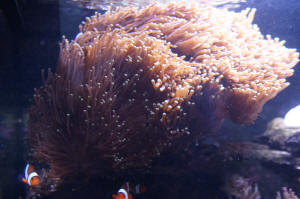 |
|
Re: Unusual Coral Frag Growth 6/23/10
Hi Bob,
<James>
Didn't really need an ID, just thought this frag was unusual
in it's formation. Generally the base and fingers grow
proportionately, at least it's been my experience. Thought I
send a pic of the parent coral even though it isn't a very
good pic. I've also attached the pic of the frag.
Got to get that 60mm macro.
James
<The first is a Seriatopora/Poritid... the second/frag... who
knows? B>
|
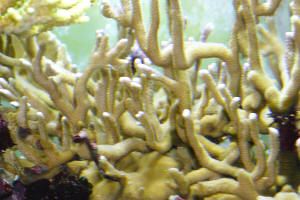 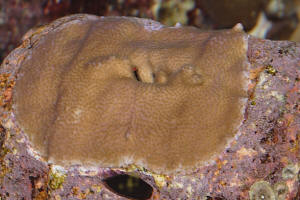 |
|
Re: Unusual Coral Frag Growth 6/23/10
That is what's unusual, the second frag (flat appearing
coral) is a frag from the Seriatopora/Poritid.
James
<We'll see... I took this to be your meaning in both
emails. B>
|
|
Re Coral Placement 5/18/10 - 5/22/10 -
5/25/10
Hi James,
<Sam>
Here are pictures. So besides the fact that you told me they need
a fine sand bed and I have crushed coral,
there are a couple more issues that I will address in order of
attachment.
Also let me know if it is labeled properly.
One was labeled as a Cynarina. It has quite a bit of skeleton
poking out.
When I did try to feed it, it blew up and very little skeleton
showed so I am hoping it will make it.
I did not see it eat but it did react.
<Appears to be a Cynarina (Button Coral)>
The next is labeled a Lobophyllia it is red with a green center
and the skeleton is poking out all around. No reaction to feeding
and I do not see any change in size. But the colors are
bright.
<Coral is in too poor a shape to ID, may be a lobo and there
are many variations within the species.>
The next was labeled a Wellsophyllia. I think it is a
Trachyphyllia.
<The Wellsophyllia Brain Coral is referred to now as a
Trachyphyllia radiata coral (Foster And Smith).>
I put it at the top of my rock, about 10 inches from top, on a
large half shell. It is about 3 inches when closed and get as big
as six inches.
I put some Mysis on it and it enveloped it. Looks very healthy
and a nice mix of colors and some green and blue sheen.
The next was labeled Wellsophyllia worm. It is green with some
purple highlights which did not show in the picture.
<Mmm, could very well be a Trachyphyllia, can be difficult to
ID, very similar to Wellsophyllia. May want to Google/research
here, I haven't the time to do so.>
It is about 3 inches when lights are out and about five when
open. I did not see any reaction when trying to feed it.
Looks very healthy to me. It is at the bottom but it really has
no room there literally between a rock and a hard place.
I got these through EBay and got more than I expected but that is
another story.
Thanks,
<You're welcome. James (Salty Dog)>
Sam
|
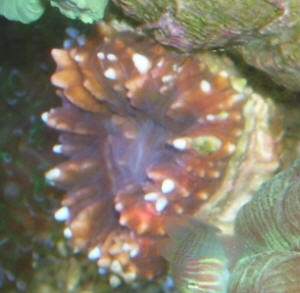 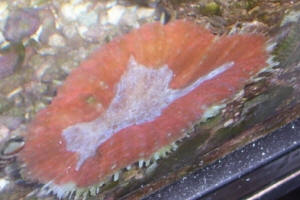
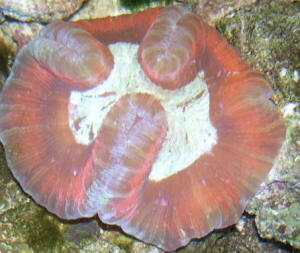 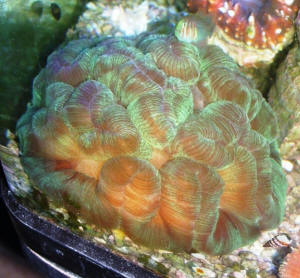 |
|
coral id 4/13/10
Hi Crew,
I am trying to identify a coral. It looks like this one (the
first one)
Cynarina lacrymalis :
http://www.wetwebmedia.com/Pix%20Of%20The%20Day%20Marine/POTD%20SW%20Arch%20
36-40/swpotdarch38.htm
but not quite the same.
<Mmm, may need to be set down on the substrate, actually
"mud"...>
Aside from the fact that the center of mine is turquoise, it also
has short hair like tentacles all around the outer
perimeter. If you look close at my picture you can see them on
the left side. One tentacle per each outer bump. And there are
more tentacles on individual bumps (not all bumps) that are not
part of the perimeter as well but I do not see any pattern. These
tentacles (if that's what they are) are out all the time. The
center is about the size of a dime and the overall size about
that of a half dollar when the lights are on. When it is
expelling stuff the center builds up to a cone shape, if that is
any clue. When I got it I thought it was a Blastomussa but ruled
it out since this lays very flat like a mushroom.
Thanks,
Sam
<I'd move this specimen... it could be a Flabellum sp.,
even a type of Lobophyllia... Bob Fenner>
|
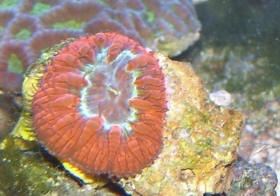 |
|
Help with coral ID please 3/29/2010
Hello there!
<Hi>
Got this from a friend that didn't know what it was either.
Wish the picture was better but it's a thick red base with
tiny green flowers that close when you touch them. Any ideas?
<Yeah... scroll through these files:
http://wetwebmedia.com/stonycoridfaq.htm
and the linked series above>
Thank you for your help and the great site.
Rhonda
<Please use it. Bob Fenner>
|
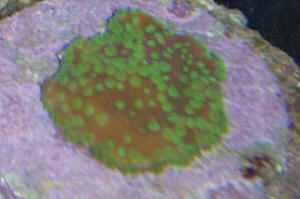 O...k... O...k... |
|
Coral ID 3/21/10
Hello Crew,
Hope you are all well!
<... 16 plus megs of pix... No searching... Idiocy>
wonder if you would be able to help me with a coral ID. I bought
this beauty a few months ago - it was sold as a Euphyllia, which
I think it may very well be...or at least some sort of
'Phyllia'.
It is not, to my eye, a Torch, Hammer, Frogspawn, Duncan,
Elegance, or any of the usual 'Phyllia' corals.
<E. glabrescens>
It is most reminiscent to me of a Duncan, with different
colouring (almost typical Torch colouring), but its skeleton is
more truncated and compact.
It has maybe 20 heads but they do not branch the way that a
Duncan/Torch etc do, and the tentacles somehow seem more
uniform.
As you can see, my clowns love it, and it loves its position high
in the tank under halides, directly in the water flow. Any
suggestions happily received!
Thanks and keep up the good work,
Lisa
<Read here: http://wetwebmedia.com/caryoeuph2.htm
and the linked files above. Bob Fenner>
|
 |
re: Coral ID 3/21/10
Hi Bob,
I apologise for my idiocy.
<Oh?>
This is not Euphyllia glabrescens. I have had many in the past
and the skeleton is entirely different to what I currently
have.
<You can see the skeleton? Can you send along an image of
this? Phaceloid? Meandroid? You have close up pix of the
corallites?>
I have spent several weeks researching this and looking through
the site and have not found this coral.
Sorry to have bothered you.
<My bet/guess is still on this Euphylliid... Please comply w/
our request going forward to limit file/image sizes to a few
hundred Kbytes per. BobF>
Re: Coral ID 3/21/10
Hello,
My only sight of the skeleton has been on moving the coral into
its current position - polyps do not retract readily at night;
however I will try to secure a (smaller) photo for you if it is
of interest.
<Up to you>
Skeletally, yes - Phaceloid (most definitely not
Meandroid/flabellomeandroid). Not the thin-septa'ed branching
form that I have often seen E. glabrescens take, however. This
individual has extremely tightly packed corallites, around 1.5 cm
in diameter - perhaps 0.5 cm between each corallite - which are
uniformly distributed, and which all extend perhaps 4 cm from the
rock base, over an area of perhaps 10 cm x 20 cm. The uniformity
of this coral is what has intrigued me.
<Does sound strange... there are other Scleractinian/families
that macroscopically look like this... but they are exceedingly
rare in the trade>
Another point, albeit minor, to mention is the tentacles - to me
they lack the slight bulbosity to the tip that I have always seen
with E. glabrescens. Might be nothing....
Will get back to you ASAP.
Thanks, Lisa
<And you, BobF>
|
|
|

